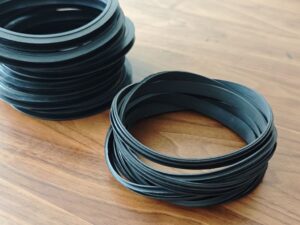When choosing materials for sealing and gasketing, Viton and EPDM are two of the most commonly considered options. While both are synthetic elastomers, their differences in properties make them suited for different applications.
Viton and EPDM differ in their temperature tolerance, chemical resistance, and application suitability. Viton is known for its superior resistance to heat and chemicals, while EPDM is preferred for outdoor applications and lower temperatures.
Understanding the core differences between Viton and EPDM is essential for selecting the right material for your project. Let's break down their unique properties and applications.
What is EPDM Rubber?
EPDM (Ethylene Propylene Diene Monomer) is a type of synthetic rubber known for its outstanding resistance to heat, ozone, and weather conditions. It's commonly used in outdoor environments.
EPDM rubber1 is an ideal choice for outdoor applications due to its resistance to UV rays, ozone, and harsh weather conditions.
Properties of EPDM
EPDM is highly resistant to oxidation, UV light, and weathering, which makes it perfect for sealing outdoor applications. It also performs well in water-based environments, offering excellent resistance to water, steam, and many types of aqueous solutions. EPDM’s main limitation is its vulnerability to oils, fuels, and other petroleum-based products. The material is often used in automotive, construction, and HVAC industries for weather stripping, seals, and gaskets, as it is well-suited for environments exposed to the elements. Its resilience to ozone degradation is another key feature, making it popular for use in rubber roofing systems, door seals, and electrical insulations.
What is Viton Rubber?
Viton, also known as fluoroelastomer, is a highly specialized material known for its excellent resistance to extreme temperatures, chemicals, and oils. It's most commonly used in applications that require durability in high-temperature and chemically aggressive environments.
Viton rubber2 excels in extreme temperature and chemical resistance, making it suitable for aerospace, automotive, and chemical industries.
Properties of Viton
Viton’s exceptional resistance to high temperatures and a broad range of chemicals is why it’s often used in industries such as aerospace, automotive, and chemical manufacturing. Viton can withstand temperatures ranging from -15°C to 200°C (5°F to 392°F), which makes it ideal for high-performance applications where other rubbers would fail. It is resistant to a wide variety of fuels, oils, acids, and solvents. However, Viton does not perform well in environments where it is exposed to water and steam for extended periods, as it is more prone to degradation under such conditions. It is commonly used in seals, gaskets, o-rings, and hoses, particularly in applications where durability and performance in extreme conditions are critical.
What are the Differences Between Viton and EPDM?
Both Viton and EPDM have distinct characteristics that make them suitable for different types of applications. Let's compare their key properties side by side.
While Viton excels in extreme heat and chemical resistance, EPDM is better suited for outdoor, weather-exposed environments. Here's a quick breakdown of their differences.
Comparison of Viton and EPDM
| Property | Viton | EPDM |
|---|---|---|
| Temperature Resistance | -15°C to 200°C (5°F to 392°F) | -50°C to 150°C (-58°F to 302°F) |
| Chemical Resistance | Excellent for oils, fuels, acids, and solvents | Good for water, steam, and UV light, but poor with oils |
| UV and Ozone Resistance | Poor | Excellent |
| Durability | Long-lasting under extreme conditions | Great for outdoor exposure |
| Cost | Higher | Lower |
| Common Applications | Automotive, aerospace, chemical processing | Roofing, HVAC, weather seals |
Which One is Better for Your Application?
The choice between Viton and EPDM depends on your specific application needs. If you're dealing with high temperatures and exposure to chemicals, Viton is likely the better choice. However, if your application involves outdoor exposure, UV light, and weathering, EPDM might be the better fit.
For high-temperature and chemical resistance, Viton is the superior choice. For outdoor weathering and UV protection, EPDM stands out.
Application Guide: When to Use Viton vs EPDM
Viton is ideal for use in harsh chemical and high-temperature environments, such as in the automotive and aerospace industries. On the other hand, EPDM is best for applications exposed to outdoor elements or those requiring resistance to water, steam, and UV degradation. EPDM’s performance in weather conditions makes it the go-to choice for applications like rubber roofing, seals for windows and doors, and automotive weather stripping.
| Application Area | Viton | EPDM |
|---|---|---|
| Automotive | Fuel and oil seals, hoses | Weather stripping, door seals |
| Aerospace | Fuel and chemical seals | Not recommended |
| Construction & HVAC | Not recommended | Roofing, weather stripping |
Conclusion
Choosing between Viton and EPDM comes down to the specific needs of your project. Viton offers unmatched performance in extreme chemical and temperature environments, while EPDM shines in outdoor, weather-exposed applications. Understanding these differences can ensure that you select the right material for the job.
Footnotes:








